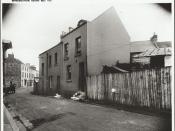A Canticle for Leibowitz was published as a book in 1959, written during the height of the 1950s concern over the danger of a nuclear war. Walter M. Miller portrays an idea of how he thinks technology will affect society many years in the future. This is not necessarily how we think technology will affect society. The role technology has on human existence and the consequence that change has on humanity are outlined and developed throughout the three separate parts of the novel: Fiat Homo, Fiat Lux and Fiat Voluntas Tua
The novel is set during a post-holocaust America where scraps of pre-war knowledge are gathered and preserved by a Catholic Church which no longer understands that knowledge. Miller remained a Catholic through much his life, though in tension with the Church, (he turned bitterly against it toward the end). This novel is distinguished by its serious consideration of religious issues.
The other most memorable feature of the books is the delightful portrait of the feckless brother Francis. "Fiat Homo" is clearly the strongest part of the work, which suffers to some degree as a novel from the very long time spans which separate each of its sections.
A Canticle for Leibowitz. is set many years in the future, after the devastation of the Nuclear Holocaust and the Flame Deluge. The bomb is assumed to be atomic or a hydrogen one. The Holocaust has destroyed any technology known to man and forced society to start over. The survivors of the holocaust rid society of any intelligence including doctors, scientists, and any who are educated. The survivors do this because they feel threatened by the knowledge people have and become simpletons. They also see the educated as the cause of the holocaust in the first place, they feel that because scientists...


